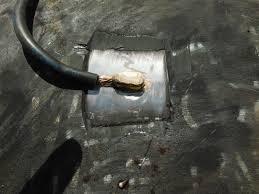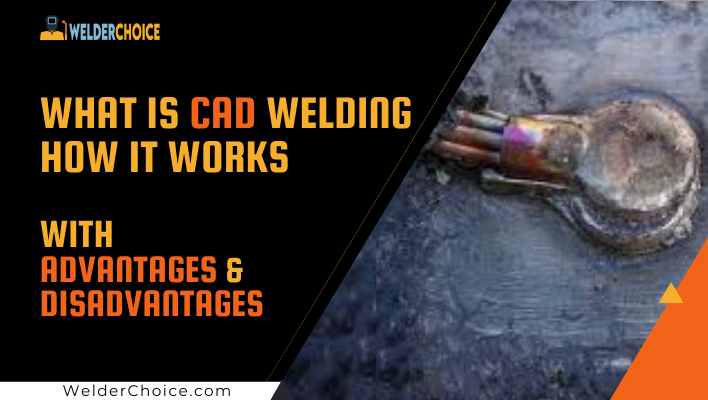It’s all about What is CAD Welding? and how its works
Exothermic welding, commonly referred to as CAD welding, is a type of welding that uses high pressure and little heat to join two metal surfaces together. It is a variation of the solid-state diffusion welding method, which employs heat produced by the pressure of the pieces being welded to forge a bond. The procedure is distinguished by its low heat input, which keeps the temperature of the components being welded low and causes less distortion and little alteration to the metal’s microstructure. This makes it the perfect welding technique for heat-sensitive materials, including those used in aerospace and other high-tech industries.

The correct execution of CAD welding is a very accurate operation that calls for a high level of ability and experience. The preparation of the surfaces to be welded is the first step in the procedure. The surfaces are then clamped together under intense pressure. The area where the pieces are in contact is heated using an electric arc, and the heat from the arc causes the metal to diffuse, forging a connection between the parts. Since the resulting bond is robust and long-lasting, it can be used in situations where a solid and durable connection is needed. The method is also
How CAD Welding Works?
Exothermic welding melts the surfaces of the materials being connected by initiating an exothermic chemical process that produces heat. The following steps are often included in the process:
- To ensure a strong bond, the two conducting materials are cleaned and prepped.
- Between the two materials is a mixture of metallic particles, often copper, and a fuel like graphite. The mixture is also referred to as “welding material” or “exothermic welding compound.”
- The exothermic reaction starts when an electrical spark ignites the fuel in the mixture. A molten pool is formed when the surfaces of the materials being connected melt due to the heat produced by the reaction. A strong, long-lasting bond between the two pieces is formed as the materials cool and the molten pool solidifies.
- When the exothermic welding process is finished, a strong, dependable bond that is appropriate for electrical and telecommunications applications is produced.
- A lasting bond between the two materials will be formed as the material cools and solidifies.
The process of exothermic welding can be done on-site and is quite easy. It also works well to join huge and many conductors, where other approaches might be problematic or unworkable.
How Hot Is CAD Welding?
A customized welding method that does not require preheating the materials prior to welding is called “CAD welding,” also known as “Cold Abutment Welding.” It produces a weld at a lower temperature than conventional welding techniques by using a specific electrode and alternating current. The individual materials being welded and the welding process utilized determine the temperature that is produced during the CAD welding process. The temperature is typically between 600 and 800 degrees Celsius, which is lower than the temperatures produced by conventional welding techniques like SMAW (Shielded Metal Arc Welding), which can reach 1200 degrees Celsius. Due to the reduced temperature, CAD welding can be carried out in a range of settings, including the ocean, without running the danger of heat-affected zones or material warping.
CAD Welding Applications
CAD welding has a number of applications in various industries, including
- Electrical and telecommunications: CAD welding is commonly used to create permanent and reliable connections between conductors in electrical and telecommunications applications. It is used to connect copper conductors, grounding systems, and lightning protection systems.
- Railways: Exothermic welding is used to join rail tracks, providing a permanent, high-strength bond between the rails.
- Power plants and substations: CAD welding is used to connect copper conductors in power plants and substations, providing a reliable and long-lasting connection.
- Marine and offshore: it is used to join copper conductors on ships and offshore platforms, providing a reliable and long-lasting connection.
- Construction: Exothermic welding is used to join copper conductors in construction, to provide a reliable and long-lasting connection.
- Industrial: it is used in industrial applications, such as welding copper conductors in industrial plants and factories, providing a reliable and long-lasting connection.
- Other industries: Exothermic welding is also used in aerospace, mining, and other industries where a strong and permanent connection is needed.
Exothermic welding is a versatile method that can be used to join a wide
range of conductive materials, including copper, aluminum, and steel, making it
suitable for a variety of applications.
Advantages and Disadvantages Exothermic Welding
Advantages
- Exothermic welding creates a bond that is highly strong and permanent, making it ideal for usage in situations where a dependable connection must last for a long time.
- Exothermic welding connections are long-lasting and require Low maintenance.
- Exothermic welding is a method for forging connections that is both easy to do and does not require a lot of equipment in low cost.
- Exothermic welding is a straightforward process that can be carried out on-site, making it a practical choice for building connections in far-off or challenging-to-reach places.
- A wide variety of conductive materials, including as copper, aluminum, and steel, can be joined using this technique.
Disadvantages
- Exothermic welding is only effective for joining conductive materials; it is ineffective when utilized with non-conductive materials.
- The process needs specialized knowledge and abilities to be carried out successfully, and only trained and qualified professionals should attempt it.
- Exothermic welding necessitates specific equipment and supplies, which may not always be easily accessible.
- Since factors like the caliber of the materials used and the operator’s expertise might have an impact on the bond quality created by exothermic welding, it is crucial to make sure the process is carried out properly.
Conclusion
What is CAD welding? as you read about it And know about how it works?
Exothermic welding is a highly effective and efficient method for creating permanent and reliable connections in electrical systems. The process uses a chemical reaction to generate heat, which melts the connecting material and fuses the two conductors together. This results in a bond that is stronger than the individual components, making it ideal for use in critical electrical systems where safety and reliability are of the utmost importance. Additionally, the process is quick and easy to perform, making it a cost-effective solution for many applications.
FAQs

With 8 years of experience a senior welding instructor and safety equipment researcher and writes articles, reviews and guidelines on helmets and other welding and safety gears at Welder Choice, and other written works have been published in various publications.
